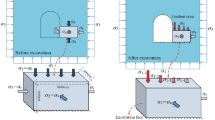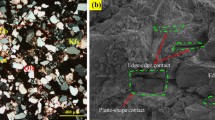Abstract
Rock-related disasters such as roof falls, sidewall spalling, and rock bursts are commonly encountered in hard rock tunnels, resulting in frequent occurrence of tunnel instability in tunneling and mining engineering. To improve the understanding of failure mechanism in hard tunnels, rocks containing one single hole with five cross-sectional shapes (circle, horseshoe, trapezoid, trapezoid and square) were modeled using the PFC (Particle Flow Code) program. Then, a series of biaxial compression tests with confining pressures of 0 MPa, 5 MPa, 10 MPa, 20 MPa and 40 MPa were conducted on these models to explore the influence of cross-sectional shape and stress condition on fracturing behavior of tunnels. Afterward, the analytical solutions of stress around the holes in rocks under different stress states were derived by the complex variable function method to interpret the fracture initiation mechanism. The results show that the mechanical property and fracturing characteristics are highly related to the hole shape and confining pressure. A total of four kinds of fractures emerges in sequence around the holes under uniaxial loading, i.e., primary tensile fracture, spalling fracture, remote fracture and shear fracture. With the growing of confining stress, the formation of tensile fractures is limited, while the initiation of the spalling fracture becomes more severe. Also, the failure mode of the pre-holed models shifts from shear failure to spalling failure. Besides, the analytical results of surrounding stress, namely tensile stress and compressive stress, distribute on the roofs/floors and sides of the holes under low lateral stress, whilst the law in case of high lateral stress is opposite, strongly explain the fracturing behavior. The research results have important guiding value for the comprehension of the fracturing behavior of rock tunnels whose axes are parallel to one of the principal stresses.







Similar content being viewed by others
References
Xie HP, Konietzky H, Zhou HW (2019) Special issue deep mining. Rock Mech Rock Eng 52(2):1415–1416
Ranjith PG, Zhao J, Ju MH, Silva DRV, Rathnaweera TD, Bandara AKMS (2017) Opportunities and challenges in deep mining: a brief review. Eng-PRC 3(4):546–551
Zheng Z, Cai ZY, Su GS, Huang SL, Wang W, Zhang Q, Wang YJ (2023) A new fractional-order model for time-dependent damage of rock under true triaxial stresses. Int J Damage Mech 32(1):50–72
Li XB, Gong FQ, Tao M, Dong LJ, Du K, Ma CD, Zhou ZL, Yin TB (2017) Failure mechanism and coupled static-dynamic loading theory in deep hard rock mining: a review. J Rock Mech Geotech Eng 9(4):767–782
Hoek E (1965) Rock fracture under static stress conditions. University of Cape Town, Cape Town
Carter BJ, Lajtai EZ, Yuan YG (1992) Tensile fracture from circular cavities loaded in compression. Int J Fract 57(3):221–236
Wang SY, Sloan SW, Sheng DC, Tang CA (2012) Numerical analysis of the failure process around a circular opening in rock. Comput Geotech 39:8–16
Wong RHC, Lin P, Tang CA (2006) Experimental and numerical study on splitting failure of brittle solids containing single pore under uniaxial compression. Mecha Mater 38(1–2):142–159
Sammis CG, Ashby MF (1986) The failure of brittle porous solids under compressive stress states. Acta Metall Sin 34(3):511–526
Dzik EJ, Lajtai EZ (1996) Primary fracture propagation from circular cavities loaded in compression. Int J Fract 79(1):49–64
Carter BJ, Lajtai EZ, Petukhov A (1991) Primary and remote fracture around underground cavities. Int J Numer Anal Met 15(1):21–40
Zhao ZL, Jing HW, Shi XS, Han GS (2022) Experimental and numerical study on mechanical and fracture behavior of rock-like specimens containing pre-existing holes flaws. Eur J Environ Civ En 26(1):1–21
Tang CA, Wong RHC, Chau KT, Lin P (2005) Modeling of compression-induced splitting failure in heterogeneous brittle porous solids. Eng Fract Mech 72(4):597–615
Lin P, Wong RHC, Tang CA (2015) Experimental study of coalescence mechanisms and failure under uniaxial compression of granite containing multiple holes. Int J Rock Mech Min Sci 77(4–6):313–327
Lajtai EZ, Lajtai VN (1975) The collapse of cavities. Int J Rock Mech Min Sci Geomech Abstr 12(4):81–86
Zhang SR, Sun B, Wang C, Yan L (2015) Influence of intermediate principal stress on failure mechanism of hard rock with a pre-existing circular opening. J Cent South Univ 21(4):1571–1582
Steen BVD, Vervoort A, Napier J (2005) Observed and simulated fracture pattern in diametrically loaded discs of rock material. Int J Fract 131(1):35–52
Haeri H, Khaloo A, Marji MF (2015) Fracture analyses of different pre-holed concrete specimens under compression. Acta Mech Sin 31(6):855–870
Wang SY, Sun L, Yang C, Yang SQ, Tang CA (2013) Numerical study on static and dynamic fracture evolution around rock cavities. J Rock Mech Geotech 5(4):262–276
Wu H, Dai B, Cheng L, Lu R, Zhao GY, Liang WZ (2021) Experimental study of dynamic mechanical response and energy dissipation of rock having a circular opening under impact loading. Min Metall Explor 38(2):1–14
Li YH, Peng JY, Zhang FP, Qiu ZG (2016) Cracking behavior and mechanism of sandstone containing a pre-cut hole under combined static and dynamic loading. Eng Geol 213:64–73
Long Y, Liu JP, Lei G, Si YT, Zhang CY, Wei DC, Shi HX (2020) Progressive fracture processes around tunnel triggered by blast disturbances under biaxial compression with different lateral pressure coefficients. T Nonferr Metal Soc 30(9):2518–2535
Tang ZL, Yao W, Zhang JC, Xu QJ, Xia KW (2019) Experimental evaluation of PMMA simulated tunnel stability under dynamic disturbance using digital image correlation. Tunn Undergr Sp Tech 92:103039
Li XB, Wu QH, Tao M, Weng L, Dong LJ (2016) Dynamic brazilian splitting test of ring-shaped specimens with different hole diameters. Rock Mech Rock Eng 49:4143–4151
Li DY, Zhu QQ, Zhou ZL, Li XB, Ranjith PG (2017) Fracture analysis of marble specimens with a hole under uniaxial compression by digital image correlation. Eng Fract Mech 183:109–124
Liu JP, Li YH, Xu SD, Xu S, Jin CY (2015) Cracking mechanisms in granite rocks subjected to uniaxial compression by moment tensor analysis of acoustic emission. Theor Appl Fract Mec 75:151–159
Zeng W, Yang SQ, Tian WL (2018) Experimental and numerical investigation of brittle sandstone specimens containing different shapes of holes under uniaxial compression. Eng Fract Mech 200:430–450
Zhou ZL, Tan LH, Cao WZ, Zhou ZY, Cai X (2017) Fracture evolution and failure behaviour of marble specimens containing rectangular cavities under uniaxial loading. Theor Appl Fract Mec 184:183–201
Tao M, Ma A, Peng K, Wang YQ, Du K (2019) Fracture evaluation and dynamic stress concentration of granite specimens containing elliptic cavity under dynamic loading. Energies 12:3441
Han ZY, Li DY, Zhu QQ, Meng L, Zhi S (2018) Dynamic fracture evolution and mechanical behavior of sandstone containing noncoplanar elliptical flaws under impact loading. Adv Civ Eng 2018:5649357
Weng L, Wu ZJ, Li XS (2018) Mesodamage characteristics of rock with a pre-cut opening under combined static–dynamic loads: a nuclear magnetic resonance (NMR) investigation. Rock Mech Rock Eng 51:2339–2354
Zheng Z, Su GS, Jiang Q, Pan PZ, Huang XH, Jiang JQ (2022) Mechanical behavior and failure mechanisms of cylindrical and prismatic rock specimens under various confining stresses. Int J Damage Mech 31(6):864–881
Lee H, Jeon S (2011) An experimental and numerical study of fracture coalescence in pre-cracked specimens under uniaxial compression. Int J Solids Struct 48(6):979–999
Li YP, Chen LZ, Wang YH (2005) Experimental research on pre-cracked marble under compression. Int J Solids Struct 42(9–10):2505–2516
Song H, Zhang H, Fu D, Kang Y, Huang G, Qu C, Cai Z (2013) Experimental study on damage evolution of rock under uniform and concentrated loading conditions using digital image correlation. Fatigue Fract Eng M 36(8):760–768
Damjanac B, Detournay C, Cundall PA (2016) Application of particle and lattice codes to simulation of hydraulic fracturing. Comp Part Mech 3:249–261
Tran KM, Bui HH, Nguyen GD (2022) DEM modelling of unsaturated seepage flows through porous media. Comp Part Mech 9:135–152
Li Y, Zhao S, Yang Z (2022) Micro instability mechanism of gravel slope based on discrete–continuous method. Comp Part Mech. https://doi.org/10.1007/s40571-022-00535-0
Wu H, Dai B, Zhao GY, Chen Y, Tian YK (2020) A novel method of calibrating micro-scale parameters of PFC model and experimental validation. Appl Sci 10(9):3221
Zheng Z, Tang H, Zhang Q, Pan PZ, Zhang XW, Mei GX, Liu ZB, Wang W (2023) True triaxial test and PFC3D-GBM simulation study on mechanical properties and fracture evolution mechanisms of rock under high stresses. Comput Geotech 154:105136
Kirsch EG (1898) Die Theorie der elastizität und die bedürfnisse der festigkeitslehre. Zeit Ver Deut Ing 42(29):797–807
Inglis CE (1913) Stresses in a plate due to the presence of cracks and sharp corners. Trans Inst Nav Arch 55:219–230
Nassar H, Nassar H, Huang GL (2019) Isotropic polar solids for conformal transformation elasticity and cloaking. J Mech Phys Solids 129:229–243
Abdou MA (2009) Goursat functions for an infinite plate with a generalized curvilinear hole in ζ-plane. Appl Math Comput 212(1):23–36
Wu H, Kulatilake PHSW, Zhao GY, Liang WZ, Wang EJ (2019) A comprehensive study of fracture evolution of brittle rock containing an inverted U-shaped cavity under uniaxial compression. Comput Geotech 116:103219
Acknowledgements
This work was jointly granted by the National Natural Science Foundations of China (52204160, 52274145), the Natural Science Foundation of Jiangsu Province (BK20210515), the China Postdoctoral Science Foundation (2022MD713814), the Systematic Project of Guangxi Key Laboratory of Disaster Prevention and Engineering Safety (2021ZDK017) and the Fundamental Research Funds for the Central Universities (2021QN1010) as well as the National Key R&D Program of China (2022YFC2905600). Besides, the authors also appreciate the support from the Yunnan Postdoctoral Science Foundation and the ''Double Innovation Plan'' of Jiangsu Province.
Author information
Authors and Affiliations
Corresponding author
Ethics declarations
Conflict of interest
The authors claim no conflict of interest.
Additional information
Publisher's Note
Springer Nature remains neutral with regard to jurisdictional claims in published maps and institutional affiliations.
Rights and permissions
Springer Nature or its licensor (e.g. a society or other partner) holds exclusive rights to this article under a publishing agreement with the author(s) or other rightsholder(s); author self-archiving of the accepted manuscript version of this article is solely governed by the terms of such publishing agreement and applicable law.
About this article
Cite this article
Wu, H., Fan, A., Ma, D. et al. Fracturing process and initiation mechanism of hard rock tunnels with different shapes: particle flow modeling and analytical study. Comp. Part. Mech. 10, 1859–1875 (2023). https://doi.org/10.1007/s40571-023-00594-x
Received:
Revised:
Accepted:
Published:
Issue Date:
DOI: https://doi.org/10.1007/s40571-023-00594-x




